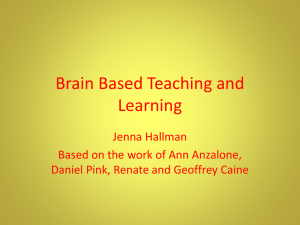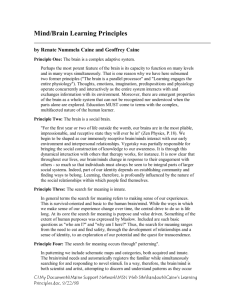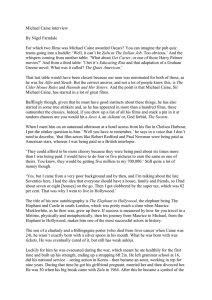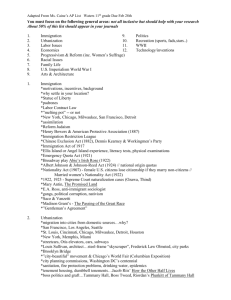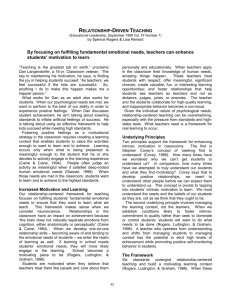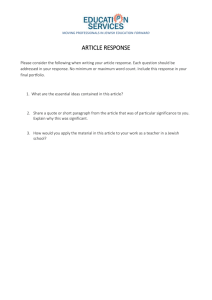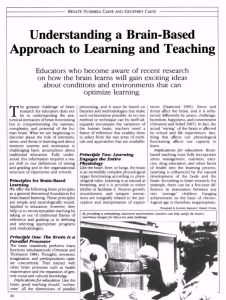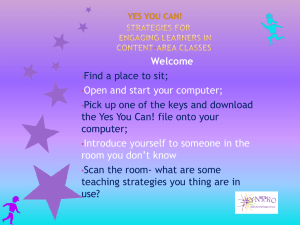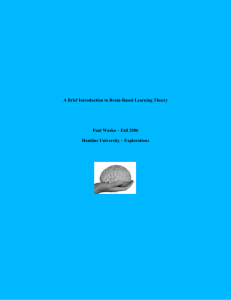Brain Based Teaching and Learning
advertisement
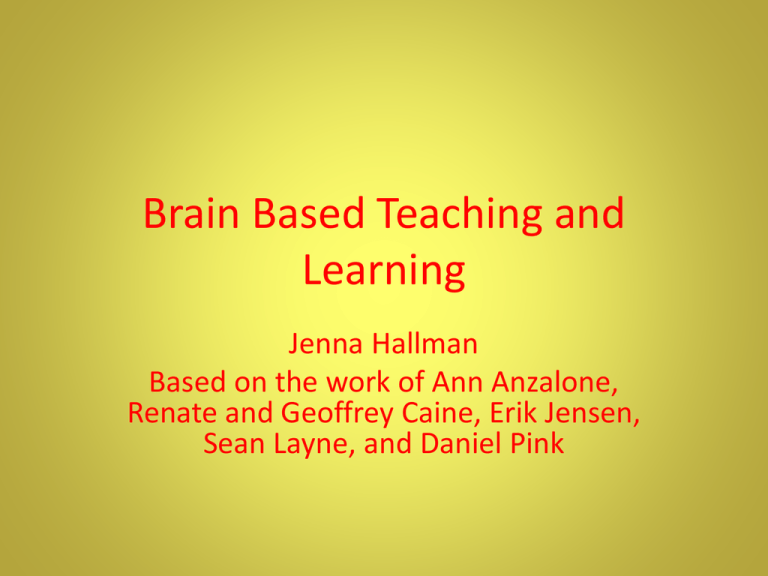
Brain Based Teaching and Learning Jenna Hallman Based on the work of Ann Anzalone, Renate and Geoffrey Caine, Erik Jensen, Sean Layne, and Daniel Pink What do you know? BrainBased • http://www.thinkingmaps.com/ Today you will learn five new ideas about brain based learning. Why Brain Based? A Few Quick Facts and Some Stretches • The brain is made up of a higher percentage of water than any other organ. • Until the age of 15, boys need more physical space in which to work. • Girls tend to learn better in groups and in darkened rooms. • The adolescent brain needs 9 hours and 15 minutes of sleep a night! 12 Core Principles - Renate Nummela Caine and Geoffrey Caine 1) Every brain is uniquely organized. Let’s take a test! Clock Partners 2) The brain is a social brain. And one more … 3) The search for meaning is innate. ABCDEFGHIJKLM NOPQRSTVWXYZ JOBINJOB VA DERS NINE CUMULUS And yet … • The end result is not automatic! • You can either hold students’ attention or they can make meaning. • Personal processing time is required. • New content/novice learners 2-5 minutes every 10-15 minutes. • Synapse between dendrites and axon strengthen when competing stimuli is eliminated. Time for a Change! • Turn to an elbow partner. • Work together to recall the first three core principles. • Brainstorm three reasons why this is important for teachers AND students. • What are your thoughts about how you can use this information with your students? It’s all about patterns! • 4) The search for meaning comes through “patterning” (organization/categorization). Immediate Memory – 30 seconds Working memory – 45 minutes Long-term memory A Safe Brain is a Learning Brain 5) Emotions are critical to patterning. • Students must feel emotionally safe and have a sense of belonging in order to learn. Using the same routines creates safety. Helping the Brain to Learn 6) Learning involves both focused attention and peripheral perception. • “That’s interesting!” • Colors, smells, shapes, rhythms • Body Mapping • Attention • Brain Breaks Time for a Change! • Find your 6:00 partner. • Decide on a way to practice principles 4-6. - Walk and talk - Create a chant - Create a tableau with another group - Ball toss • Find a new place to sit. Right Brain or Left Brain 7) We have at least two types of memory –a spatial memory system (autobiographical) and a set of systems for rote learning. 8) The brain simultaneously perceives and creates wholes (big picture = right) and parts (details = left). It’s all Connected! 9) Learning involves the entire physiology. 10) The brain is a parallel processor (colateral). Brain Dance by Anne Green Gilbert: • • • • • • • • Breath Tactile Core-Distal Stretch Head-Tail Curl Upper-Lower Body-Side Cross-Lateral Vestibular Balancing the Brain 11) Learning involves both conscious and unconscious processes. • Singing, Music, and Laughing • Verbalize thought process Finally … 12) Learning is enhanced by challenge and inhibited by threat. Under stress we go to our primary brain. • Game Time Random Thoughts • We comprehend 4x higher than we can read • Females use 25,000 words per day/ Males use 12,500 • Age + 2 minutes = how often students must share (include visual options) • Schedule for Long Term Memory - 10 minutes after teaching -1 day after teaching -1 week after teaching -1 month after teaching -3 months after teaching • The best way to get children thinking is to have them write every day. What do you know? BrainBased • http://www.thinkingmaps.com/ Resources • Ann Anzalone: Learning with Thinking in Mind http://annanzalone.com/ • Renate and Geoffrey Caine http://www.mainesupportnetwork.org/handouts /pdf/Caine's.pdf • Jensen, E. (1998). Teaching with the brain in mind. Alexandria: ASCD. • Pink, D. H. (2006). A whole new mind. New York: Riverhead Books. • Thinking Maps: http://www.thinkingmaps.com/ In the end, all that matters is what you think, because if you don’t think it, it can’t exist for you. • Jenna Hallman hallmanj@cerra.org
